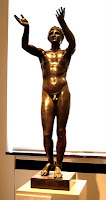Yesterday, both Bob and I slept most of the 2:20 plane ride from St. Petersburg to Berlin, so when we woke, it was as if the former were a dream and we'd landed on a new planet. Niko was gone, and instead we had Karin, whom her husband called our “native tongue talker.” On the cab ride to our hotel, she and the driver jabbered away in German with gusto and hilarity, which set a positive introduction to the last leg of our trip.
 |
| Altes Museum |
 |
| Neues Museum |
For our first day in Berlin, the #100 bus took us to Museum Island, a collection of five museums in the Spree River. We visited only two of them, the Altes (old) and the Neues (new). Since Berlin was mostly reduced to rubble by 1945, the Germans, like the Russians, had a choice: rebuild or restore. The Russians rebuilt their famous buildings to look the way they had before the war; the Germans restored what was left of theirs. The Neues Museum, which the Nazis closed in 1939, reopened seventy years later, in 2009!
The building retained its footprint, but most of its rooms were made of new materials into which, like random pieces of mosaic, the builders inserted broken segments of the old walls or ceilings. The result was effective, but totally different from the rebuilt buildings of St. Petersburg.
 |
| Antinous |
 |
| Praying Boy |
The Altes Museum had a stunning collection of Etruscan, Greek and Roman sculptures and artifacts including several busts and even one larger-than-life statue of Antinous, the young lover of Hadrian, who drowned in the Nile at 21 and was then made a god. It also had a striking bronze statue from the Island of Rhodes, The Praying Boy, dating back 2300 years.
The Newes Museum, although it had some Roman pieces, focused mainly on Egyptian art. In a room of her own was perhaps the world's most famous bust, Queen Nerertiti, who is every bit as beautiful and amazing as we had hoped she would be. Not only was she a supermodel for the ages (beginning 3340 years ago), she was also a recognizable human being.
 |
| Ephraim Palais |
We then went off the island in search of the Ephraim Palais, an 18th Century house built on a curve in the street by Frederich the Great's banker. The architect solved the challenge of building on the site by making the central room an oval to correspond with the street, and two wings running straight on either side. Unfortunately, although the building's shell was elegant, it had no period furnishings and is now used to display totally unrelated exhibits. This was disappointing, but right next to it was a delightful square where we could sit outside for our well-earned Kaffee und Kuchen.
 The trip back to the hotel was an adventure, since all the roads around the museums were closed for a bike race. No buses, no taxis, no way home. So we limped down Unter den Linden until Bob and our native tongue talker discovered a subway station and guided us back via the City's major train station, Hauptbahnhof.
The trip back to the hotel was an adventure, since all the roads around the museums were closed for a bike race. No buses, no taxis, no way home. So we limped down Unter den Linden until Bob and our native tongue talker discovered a subway station and guided us back via the City's major train station, Hauptbahnhof.